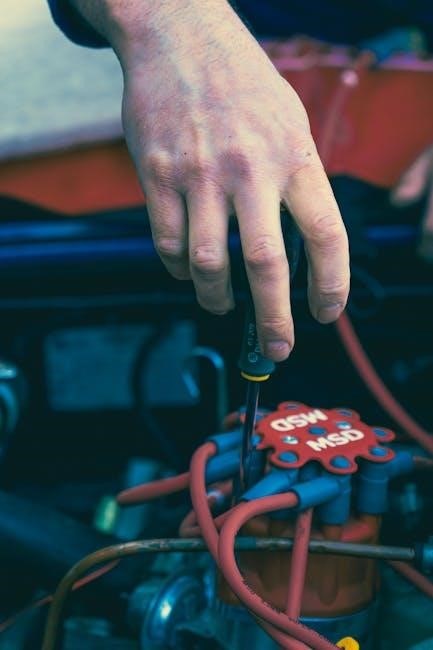Manual de Reparación de Motor Kohler: Guía Integral
This comprehensive guide provides essential information for repairing Kohler engines. It contains necessary instructions for proper engine maintenance, ensuring years of steady performance. Technical documents and manuals help you learn more about your Kohler engine and troubleshoot issues.

Introducción a los Manuales de Reparación Kohler
Kohler engine repair manuals are indispensable resources for anyone seeking to maintain, troubleshoot, or overhaul their Kohler engines. These manuals contain detailed information about various engine models, offering step-by-step instructions, diagrams, and specifications necessary for effective repairs. Understanding the importance of these manuals is crucial for both seasoned mechanics and DIY enthusiasts. They provide insights into engine components, operating principles, and potential issues that may arise over time.
Kohler’s commitment to quality extends to its repair manuals, ensuring accuracy and clarity in the information provided. Whether you’re dealing with a small engine on a lawnmower or a larger engine in industrial equipment, a Kohler repair manual serves as a reliable guide. It helps in identifying parts, understanding assembly sequences, and performing necessary adjustments to keep your engine running smoothly. Furthermore, adhering to the manual’s instructions ensures that repairs are carried out safely and effectively, minimizing the risk of further damage or injury.
These manuals often include troubleshooting sections, helping users diagnose common problems and identify the root cause of malfunctions. With the right manual, you can confidently tackle engine repairs, saving time and money while extending the lifespan of your Kohler engine. Always refer to the specific manual for your engine model to ensure accuracy and compatibility.
Identificación del Modelo de Motor Kohler
Accurately identifying your Kohler engine model is the first and most crucial step in any repair or maintenance endeavor. Kohler produces a wide array of engines, each with unique specifications and repair procedures. Using the correct repair manual tailored to your specific engine model ensures that you have the right information for parts, torque settings, and assembly instructions.
Typically, the engine model number is stamped on a metal tag or sticker affixed to the engine. This tag is usually found on the engine block, valve cover, or near the starter. The model number is a combination of letters and numbers that precisely identifies the engine series, horsepower, and other critical details. For instance, you might find a model number like “K181” or “Command PRO CS.”
Once you locate the model number, you can use it to find the corresponding repair manual on the Kohler Engines website or through authorized Kohler dealers. Having the correct manual will prevent costly errors and ensure that you’re using the appropriate parts and procedures. Keep in mind that even slight variations within an engine series can significantly impact repair processes, so accurate identification is paramount for successful engine maintenance and repair.
Herramientas Necesarias para la Reparación
Before commencing any repair work on your Kohler engine, it’s essential to gather the necessary tools. Having the right tools not only makes the job easier but also ensures that you don’t damage any engine components during disassembly or reassembly. A basic set of tools should include a socket set, wrenches (both open-end and box-end), screwdrivers (Phillips head and flathead), pliers, and a torque wrench. A torque wrench is particularly important for tightening bolts to the manufacturer’s specified torque settings.

In addition to these basic tools, you may also need specialized tools depending on the specific repair. These might include a valve spring compressor for valve work, a piston ring compressor for reassembling pistons, and a flywheel puller for removing the flywheel. A multimeter can be useful for diagnosing electrical issues, and a compression tester can help assess the engine’s overall health.
Furthermore, it’s a good idea to have cleaning supplies on hand, such as degreaser, brushes, and cloths, to clean parts as you disassemble the engine. Proper organization of your tools and parts is also crucial to prevent losing anything and to keep the workspace tidy. Investing in a well-stocked toolbox will pay off in the long run by making your engine repair projects more efficient and less frustrating.
Precauciones de Seguridad Antes de Comenzar

Prioritizing safety is paramount before initiating any repair work on a Kohler engine. Always disconnect the spark plug lead to prevent accidental starting, grounding the lead to avoid any electrical discharge. Never touch the engine immediately after it has been running, as parts may be extremely hot and cause burns. Ensure adequate ventilation in the workspace to avoid inhaling harmful exhaust gases. Lethal exhaust gases can accumulate in closed or confined areas.
When handling fuel, exercise extreme caution. Do not fill the fuel tank while the engine is hot or running, as spilled fuel could ignite. Avoid contact with hot engine parts or sparks from ignition. Wear appropriate personal protective equipment (PPE), including safety glasses and gloves, to protect your eyes and skin from potential hazards such as fuel, oil, and sharp objects.
Before disassembling any engine components, relieve any pressure in the fuel or oil systems. Properly support the engine during repairs to prevent it from tipping or falling. Be mindful of pinch points and moving parts. If you are unfamiliar with engine repair, seek guidance from a qualified mechanic or consult the Kohler engine repair manual for detailed instructions and safety guidelines.
Desmontaje del Motor Kohler: Paso a Paso
Disassembling a Kohler engine requires a systematic approach. Begin by draining all fluids, including fuel and oil, into appropriate containers. Disconnect the spark plug wire and any other electrical connections. Remove the air cleaner assembly, followed by the carburetor, carefully noting the placement of any linkages or springs. Next, detach the exhaust system, taking care to avoid damaging any gaskets or mounting hardware;
Proceed to remove the engine shroud and any other external components that obstruct access to the engine’s internal parts. Carefully detach the cylinder head, loosening the bolts in a crisscross pattern to prevent warping. Remove the pushrods and rocker arms, keeping them organized for reassembly. Next, remove the oil pan and oil pump, followed by the connecting rod caps and pistons. Inspect the cylinder walls for any signs of wear or damage before removing the crankshaft.
As you disassemble the engine, label and organize all parts to ensure proper reassembly. Take photographs or make sketches to document the location of components and the routing of wires and hoses. Clean each part thoroughly before inspecting it for wear or damage. Consult the Kohler engine repair manual for specific instructions and torque specifications for your engine model. This meticulous approach will facilitate a smooth and successful reassembly process.
Inspección de Componentes del Motor
After disassembling your Kohler engine, a thorough inspection of each component is crucial. Start by examining the cylinder walls for scratches, scoring, or excessive wear. Measure the cylinder bore to ensure it’s within specified limits. Inspect the pistons for cracks, damage, or excessive carbon buildup. Check the piston rings for wear and proper sealing. Examine the connecting rods for any signs of bending or damage, paying close attention to the bearing surfaces.
Next, inspect the crankshaft for wear, cracks, or damage to the bearing journals. Measure the crankshaft journals to ensure they are within specified tolerances. Examine the camshaft for worn or damaged lobes. Inspect the valve train components, including the valves, valve guides, and valve springs, for wear or damage. Check the cylinder head for cracks, warping, or damage to the valve seats.
Inspect all bearings for wear, scoring, or discoloration. Replace any bearings that show signs of damage. Examine the oil pump for wear and proper operation. Check all gaskets and seals for leaks or damage. Replace any gaskets or seals that are worn or damaged. Clean all parts thoroughly before reassembly. Consult the Kohler engine repair manual for specific inspection procedures and wear limits for your engine model. This meticulous inspection will help identify any potential problems and ensure a successful engine repair.
Reparación y Reemplazo de Partes Dañadas
Following a thorough inspection, address any damaged or worn components. Minor cylinder wall scratches can often be removed with honing. If the cylinder bore is beyond specifications, consider reboring and installing oversized pistons. Replace pistons with cracks or significant damage. Install new piston rings if the old ones are worn or not sealing properly. Replace connecting rods if they are bent or damaged. If the crankshaft journals are worn, consider grinding them to the next undersize and using appropriate bearings.
Replace camshafts with worn lobes. Reface or replace valves with worn faces or stems. Replace valve guides if they are excessively worn. Install new valve springs if they are weak or damaged. If the cylinder head is cracked or warped, it may need to be replaced or resurfaced. Replace worn bearings with new ones of the correct size. Repair or replace the oil pump if it is not functioning correctly.
Always use genuine Kohler parts or high-quality aftermarket parts for replacements to ensure proper fit and performance. Follow the manufacturer’s recommendations for torque specifications and installation procedures. Consult the Kohler engine repair manual for specific instructions on repairing or replacing each component. Proper repair and replacement of damaged parts are crucial for restoring the engine to optimal condition and ensuring reliable operation.
Montaje del Motor Kohler: Secuencia Correcta
Reassembling a Kohler engine requires meticulous attention to detail and adherence to the correct sequence. Begin by installing the crankshaft into the engine block, ensuring proper bearing alignment and lubrication. Next, install the connecting rods and pistons, carefully aligning the piston rings and securing the connecting rod caps with the specified torque. Install the camshaft and valve train components, ensuring proper timing and valve clearance.
Attach the cylinder head to the engine block, using a new head gasket and tightening the head bolts in the correct sequence and to the specified torque. Install the intake and exhaust manifolds, carburetor, and other external components. Reinstall the oil pan, ensuring a proper seal to prevent oil leaks. Replace all gaskets and seals to prevent leaks and ensure proper engine operation.
Double-check all connections and ensure that all components are properly installed and tightened. Consult the Kohler engine repair manual for specific instructions and torque specifications. Following the correct assembly sequence is crucial for ensuring proper engine function and preventing damage. Take your time and pay close attention to detail to ensure a successful engine rebuild.
Ajuste y Calibración del Motor Reparado
After reassembling your Kohler engine, precise adjustment and calibration are crucial for optimal performance. Begin by setting the valve lash according to the manufacturer’s specifications, ensuring proper valve timing and compression. Adjust the carburetor to achieve the correct air-fuel mixture, optimizing fuel efficiency and minimizing emissions. Use a tachometer to verify the engine’s idle speed and adjust it to the recommended RPM.
Check the ignition timing and adjust it as needed to ensure proper spark advance. Verify the governor’s operation and adjust it to maintain consistent engine speed under varying loads. Inspect the cooling system and ensure proper coolant levels and circulation. Test the engine under load to identify any performance issues and make further adjustments as necessary.
Refer to the Kohler engine repair manual for specific adjustment procedures and specifications. Use precision tools and measuring instruments to ensure accurate adjustments. Proper adjustment and calibration will maximize engine power, improve fuel economy, and extend engine life. Take the time to fine-tune your engine for peak performance and reliable operation.
Mantenimiento Preventivo del Motor Kohler
Regular preventative maintenance is essential for prolonging the life and ensuring the efficient operation of your Kohler engine. Begin by performing regular oil changes, using the recommended oil type and following the manufacturer’s suggested intervals. Inspect and clean or replace the air filter to maintain proper airflow and prevent engine damage.
Check the spark plug condition and replace it as needed to ensure reliable ignition. Inspect the fuel filter and replace it regularly to prevent fuel contamination. Examine the cooling system and ensure proper coolant levels and circulation. Check the belts and hoses for wear and tear and replace them as necessary.

Clean the engine regularly to remove dirt and debris that can cause overheating or other problems. Inspect the engine for leaks and address them promptly to prevent further damage. Lubricate all moving parts as recommended by the manufacturer. Store the engine properly when not in use, following the manufacturer’s instructions.
By adhering to a consistent preventative maintenance schedule, you can minimize the risk of costly repairs and extend the life of your Kohler engine. Consult your Kohler engine repair manual for specific maintenance recommendations and schedules.
